NUR-440 Research: An Annotated Bibliography on Barcode Systems Impact
VerifiedAdded on 2023/03/30
|10
|2035
|492
Annotated Bibliography
AI Summary
This annotated bibliography examines the impact of barcode systems on reducing medication errors in healthcare settings. It includes annotations of six research articles that investigate the effectiveness of barcode medication administration (BCMA) technology and electronic medication administration records (eMAR) in improving patient safety and minimizing medication errors. The studies utilize various research methods, including retrospective comparisons, systematic reviews, qualitative descriptive studies, and observational studies, to assess the impact of barcode systems on medication administration accuracy. The findings consistently suggest that barcode systems contribute to a significant reduction in medication errors, enhance patient safety, and improve the overall quality of healthcare delivery by providing a safer medication practice and treatment environment for both nurses and patients. The reviewed articles offer insights into the factors associated with BCMA technology that contribute to patient safety and the perceptions of healthcare professionals regarding the use of barcode systems in medication administration.
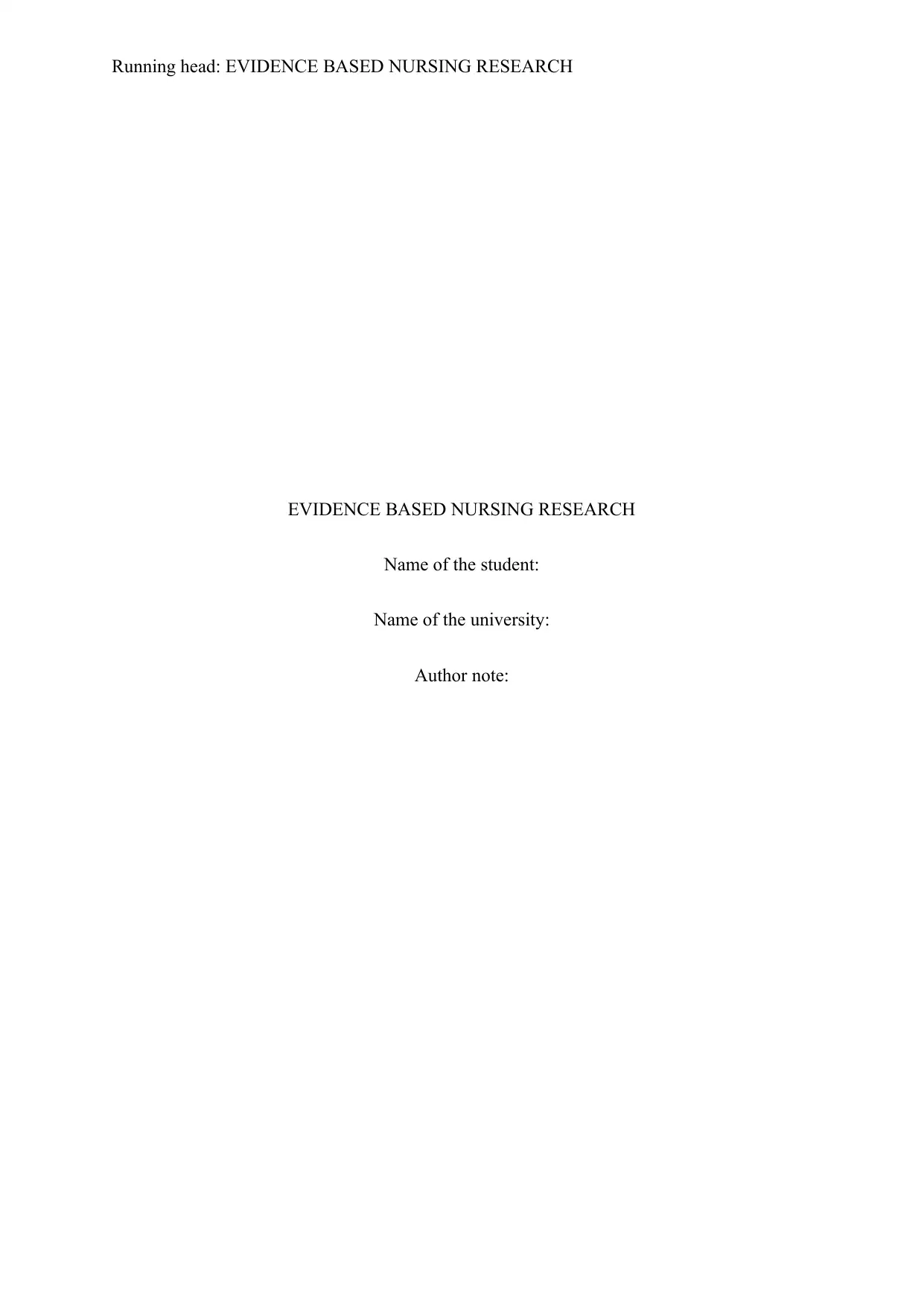
Running head: EVIDENCE BASED NURSING RESEARCH
EVIDENCE BASED NURSING RESEARCH
Name of the student:
Name of the university:
Author note:
EVIDENCE BASED NURSING RESEARCH
Name of the student:
Name of the university:
Author note:
Paraphrase This Document
Need a fresh take? Get an instant paraphrase of this document with our AI Paraphraser
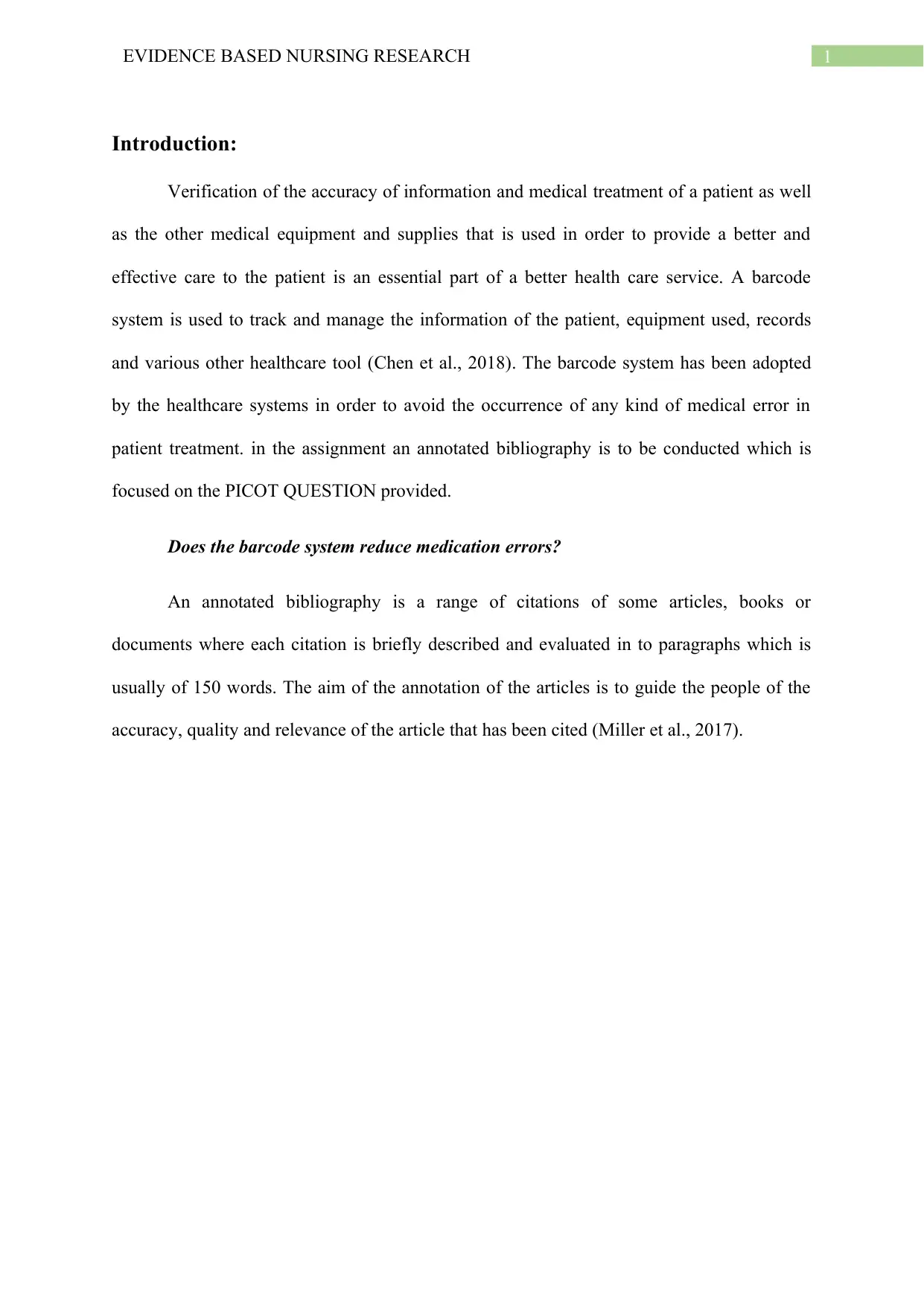
1EVIDENCE BASED NURSING RESEARCH
Introduction:
Verification of the accuracy of information and medical treatment of a patient as well
as the other medical equipment and supplies that is used in order to provide a better and
effective care to the patient is an essential part of a better health care service. A barcode
system is used to track and manage the information of the patient, equipment used, records
and various other healthcare tool (Chen et al., 2018). The barcode system has been adopted
by the healthcare systems in order to avoid the occurrence of any kind of medical error in
patient treatment. in the assignment an annotated bibliography is to be conducted which is
focused on the PICOT QUESTION provided.
Does the barcode system reduce medication errors?
An annotated bibliography is a range of citations of some articles, books or
documents where each citation is briefly described and evaluated in to paragraphs which is
usually of 150 words. The aim of the annotation of the articles is to guide the people of the
accuracy, quality and relevance of the article that has been cited (Miller et al., 2017).
Introduction:
Verification of the accuracy of information and medical treatment of a patient as well
as the other medical equipment and supplies that is used in order to provide a better and
effective care to the patient is an essential part of a better health care service. A barcode
system is used to track and manage the information of the patient, equipment used, records
and various other healthcare tool (Chen et al., 2018). The barcode system has been adopted
by the healthcare systems in order to avoid the occurrence of any kind of medical error in
patient treatment. in the assignment an annotated bibliography is to be conducted which is
focused on the PICOT QUESTION provided.
Does the barcode system reduce medication errors?
An annotated bibliography is a range of citations of some articles, books or
documents where each citation is briefly described and evaluated in to paragraphs which is
usually of 150 words. The aim of the annotation of the articles is to guide the people of the
accuracy, quality and relevance of the article that has been cited (Miller et al., 2017).
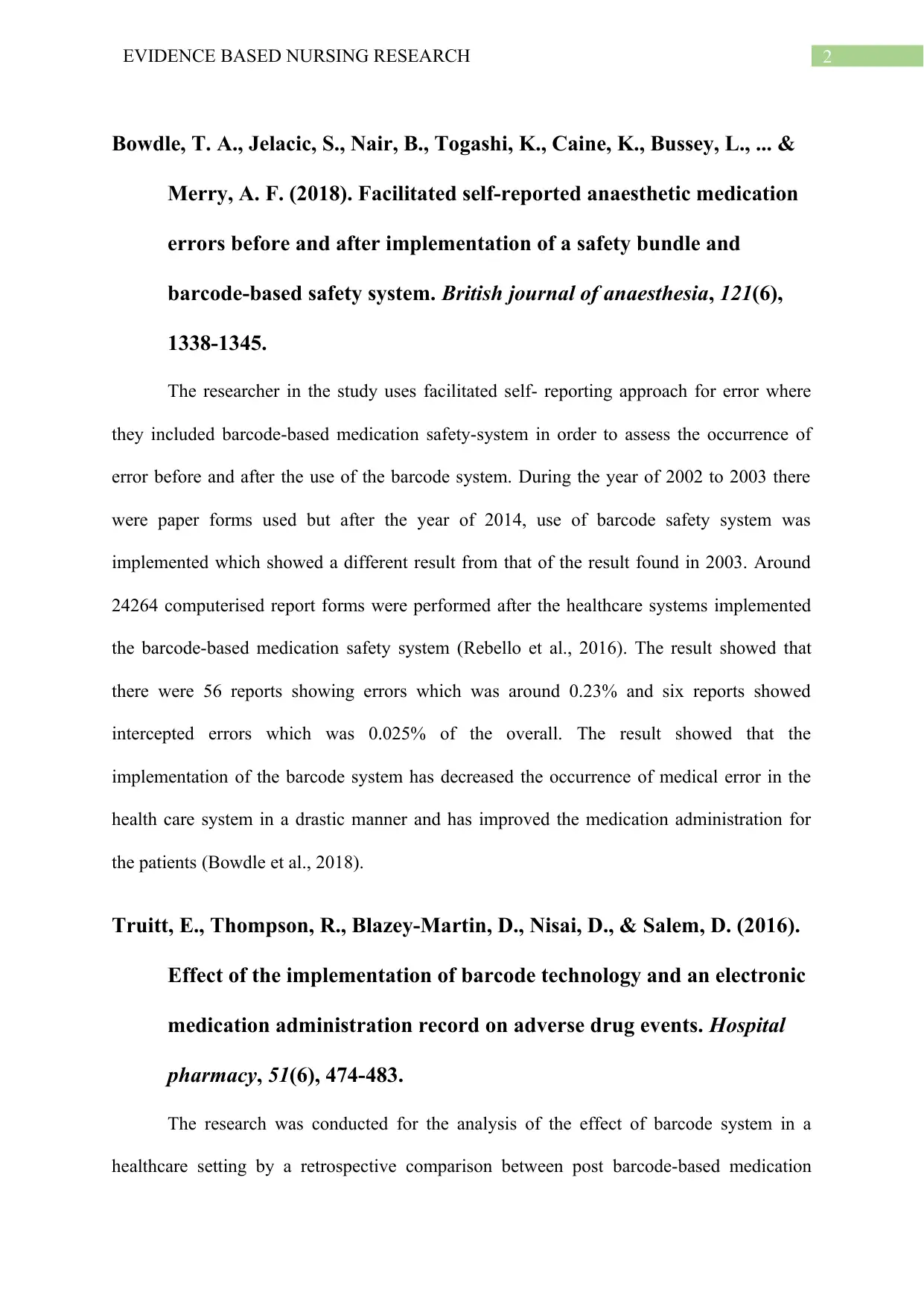
2EVIDENCE BASED NURSING RESEARCH
Bowdle, T. A., Jelacic, S., Nair, B., Togashi, K., Caine, K., Bussey, L., ... &
Merry, A. F. (2018). Facilitated self-reported anaesthetic medication
errors before and after implementation of a safety bundle and
barcode-based safety system. British journal of anaesthesia, 121(6),
1338-1345.
The researcher in the study uses facilitated self- reporting approach for error where
they included barcode-based medication safety-system in order to assess the occurrence of
error before and after the use of the barcode system. During the year of 2002 to 2003 there
were paper forms used but after the year of 2014, use of barcode safety system was
implemented which showed a different result from that of the result found in 2003. Around
24264 computerised report forms were performed after the healthcare systems implemented
the barcode-based medication safety system (Rebello et al., 2016). The result showed that
there were 56 reports showing errors which was around 0.23% and six reports showed
intercepted errors which was 0.025% of the overall. The result showed that the
implementation of the barcode system has decreased the occurrence of medical error in the
health care system in a drastic manner and has improved the medication administration for
the patients (Bowdle et al., 2018).
Truitt, E., Thompson, R., Blazey-Martin, D., Nisai, D., & Salem, D. (2016).
Effect of the implementation of barcode technology and an electronic
medication administration record on adverse drug events. Hospital
pharmacy, 51(6), 474-483.
The research was conducted for the analysis of the effect of barcode system in a
healthcare setting by a retrospective comparison between post barcode-based medication
Bowdle, T. A., Jelacic, S., Nair, B., Togashi, K., Caine, K., Bussey, L., ... &
Merry, A. F. (2018). Facilitated self-reported anaesthetic medication
errors before and after implementation of a safety bundle and
barcode-based safety system. British journal of anaesthesia, 121(6),
1338-1345.
The researcher in the study uses facilitated self- reporting approach for error where
they included barcode-based medication safety-system in order to assess the occurrence of
error before and after the use of the barcode system. During the year of 2002 to 2003 there
were paper forms used but after the year of 2014, use of barcode safety system was
implemented which showed a different result from that of the result found in 2003. Around
24264 computerised report forms were performed after the healthcare systems implemented
the barcode-based medication safety system (Rebello et al., 2016). The result showed that
there were 56 reports showing errors which was around 0.23% and six reports showed
intercepted errors which was 0.025% of the overall. The result showed that the
implementation of the barcode system has decreased the occurrence of medical error in the
health care system in a drastic manner and has improved the medication administration for
the patients (Bowdle et al., 2018).
Truitt, E., Thompson, R., Blazey-Martin, D., Nisai, D., & Salem, D. (2016).
Effect of the implementation of barcode technology and an electronic
medication administration record on adverse drug events. Hospital
pharmacy, 51(6), 474-483.
The research was conducted for the analysis of the effect of barcode system in a
healthcare setting by a retrospective comparison between post barcode-based medication
⊘ This is a preview!⊘
Do you want full access?
Subscribe today to unlock all pages.

Trusted by 1+ million students worldwide
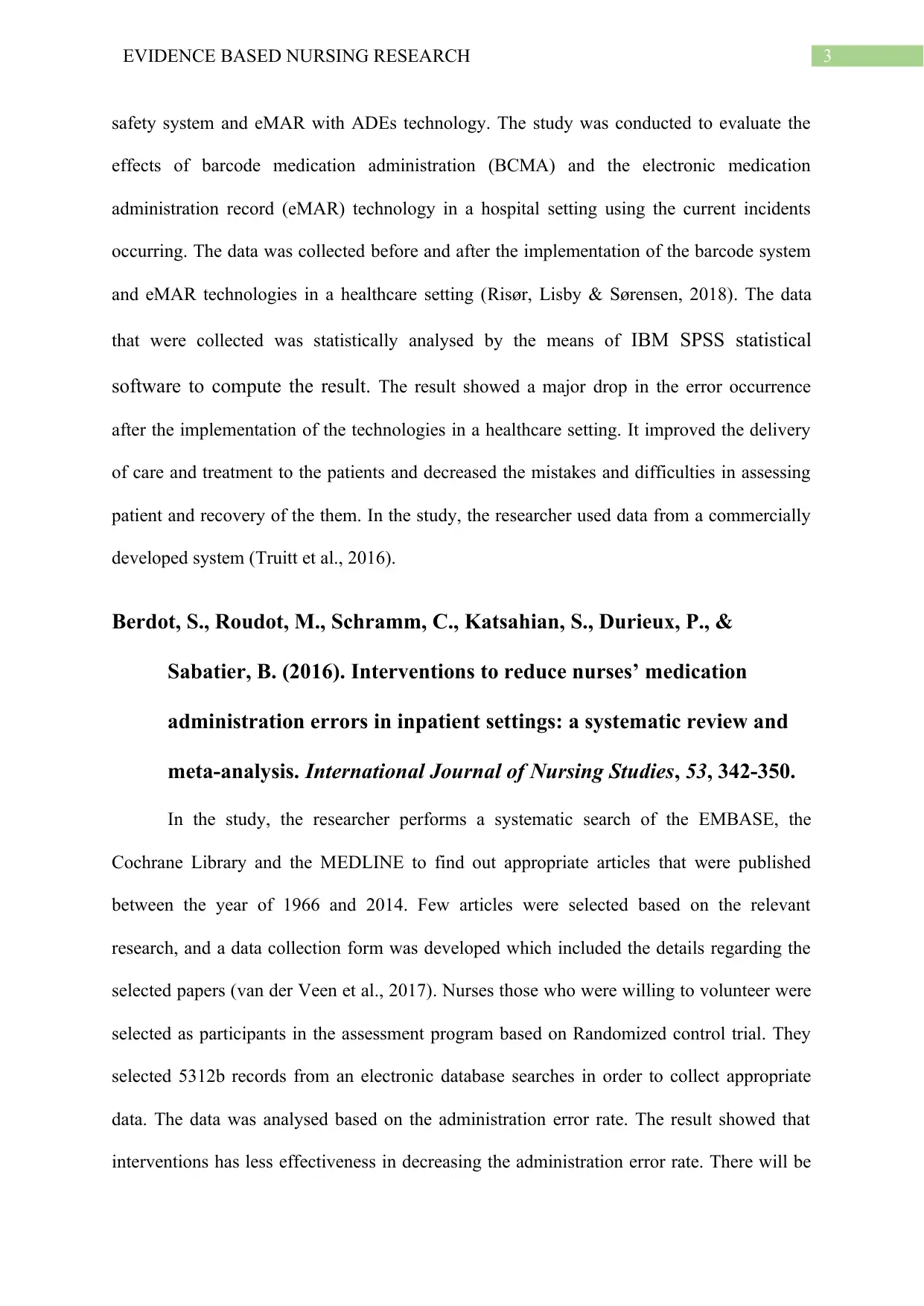
3EVIDENCE BASED NURSING RESEARCH
safety system and eMAR with ADEs technology. The study was conducted to evaluate the
effects of barcode medication administration (BCMA) and the electronic medication
administration record (eMAR) technology in a hospital setting using the current incidents
occurring. The data was collected before and after the implementation of the barcode system
and eMAR technologies in a healthcare setting (Risør, Lisby & Sørensen, 2018). The data
that were collected was statistically analysed by the means of IBM SPSS statistical
software to compute the result. The result showed a major drop in the error occurrence
after the implementation of the technologies in a healthcare setting. It improved the delivery
of care and treatment to the patients and decreased the mistakes and difficulties in assessing
patient and recovery of the them. In the study, the researcher used data from a commercially
developed system (Truitt et al., 2016).
Berdot, S., Roudot, M., Schramm, C., Katsahian, S., Durieux, P., &
Sabatier, B. (2016). Interventions to reduce nurses’ medication
administration errors in inpatient settings: a systematic review and
meta-analysis. International Journal of Nursing Studies, 53, 342-350.
In the study, the researcher performs a systematic search of the EMBASE, the
Cochrane Library and the MEDLINE to find out appropriate articles that were published
between the year of 1966 and 2014. Few articles were selected based on the relevant
research, and a data collection form was developed which included the details regarding the
selected papers (van der Veen et al., 2017). Nurses those who were willing to volunteer were
selected as participants in the assessment program based on Randomized control trial. They
selected 5312b records from an electronic database searches in order to collect appropriate
data. The data was analysed based on the administration error rate. The result showed that
interventions has less effectiveness in decreasing the administration error rate. There will be
safety system and eMAR with ADEs technology. The study was conducted to evaluate the
effects of barcode medication administration (BCMA) and the electronic medication
administration record (eMAR) technology in a hospital setting using the current incidents
occurring. The data was collected before and after the implementation of the barcode system
and eMAR technologies in a healthcare setting (Risør, Lisby & Sørensen, 2018). The data
that were collected was statistically analysed by the means of IBM SPSS statistical
software to compute the result. The result showed a major drop in the error occurrence
after the implementation of the technologies in a healthcare setting. It improved the delivery
of care and treatment to the patients and decreased the mistakes and difficulties in assessing
patient and recovery of the them. In the study, the researcher used data from a commercially
developed system (Truitt et al., 2016).
Berdot, S., Roudot, M., Schramm, C., Katsahian, S., Durieux, P., &
Sabatier, B. (2016). Interventions to reduce nurses’ medication
administration errors in inpatient settings: a systematic review and
meta-analysis. International Journal of Nursing Studies, 53, 342-350.
In the study, the researcher performs a systematic search of the EMBASE, the
Cochrane Library and the MEDLINE to find out appropriate articles that were published
between the year of 1966 and 2014. Few articles were selected based on the relevant
research, and a data collection form was developed which included the details regarding the
selected papers (van der Veen et al., 2017). Nurses those who were willing to volunteer were
selected as participants in the assessment program based on Randomized control trial. They
selected 5312b records from an electronic database searches in order to collect appropriate
data. The data was analysed based on the administration error rate. The result showed that
interventions has less effectiveness in decreasing the administration error rate. There will be
Paraphrase This Document
Need a fresh take? Get an instant paraphrase of this document with our AI Paraphraser
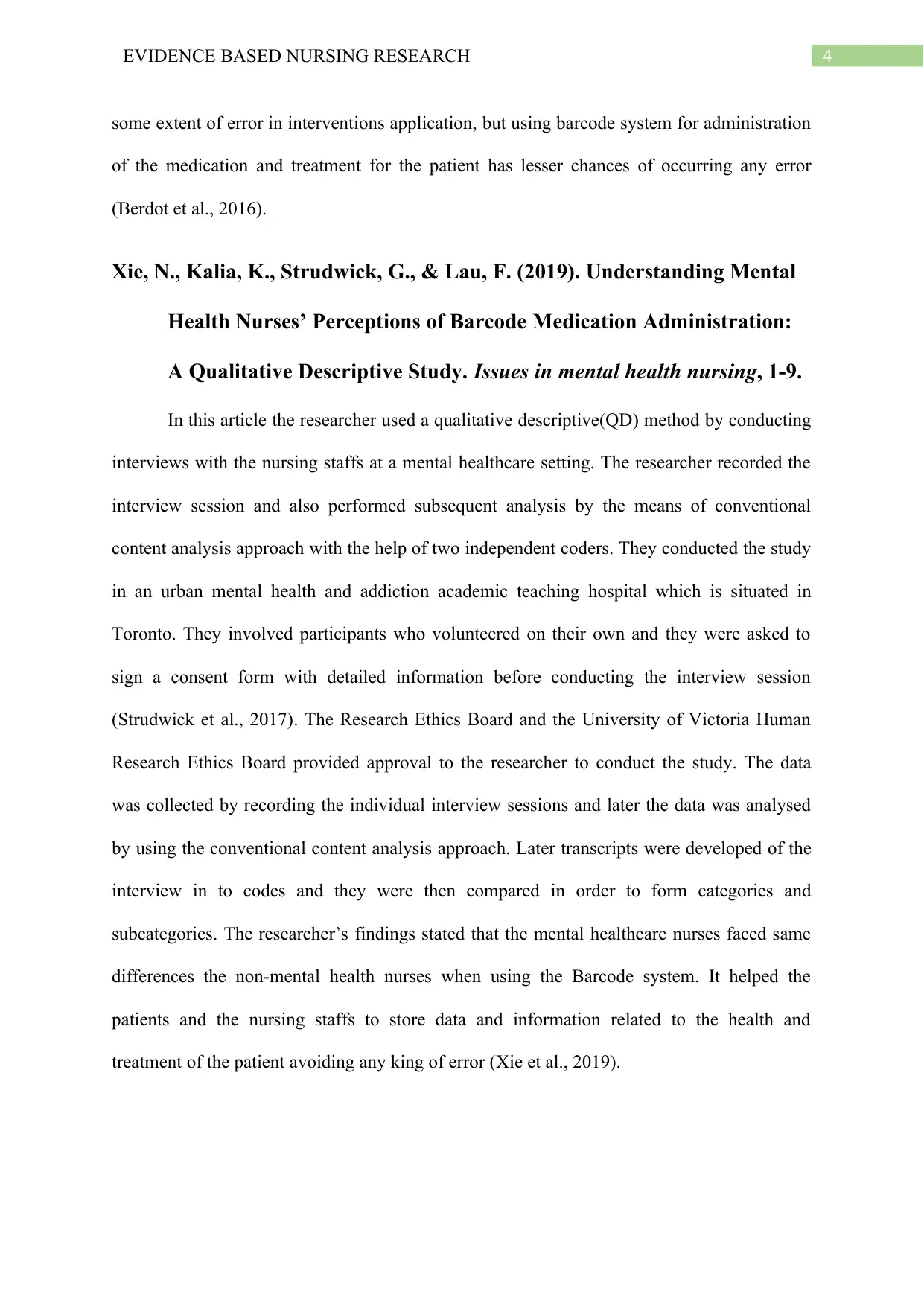
4EVIDENCE BASED NURSING RESEARCH
some extent of error in interventions application, but using barcode system for administration
of the medication and treatment for the patient has lesser chances of occurring any error
(Berdot et al., 2016).
Xie, N., Kalia, K., Strudwick, G., & Lau, F. (2019). Understanding Mental
Health Nurses’ Perceptions of Barcode Medication Administration:
A Qualitative Descriptive Study. Issues in mental health nursing, 1-9.
In this article the researcher used a qualitative descriptive(QD) method by conducting
interviews with the nursing staffs at a mental healthcare setting. The researcher recorded the
interview session and also performed subsequent analysis by the means of conventional
content analysis approach with the help of two independent coders. They conducted the study
in an urban mental health and addiction academic teaching hospital which is situated in
Toronto. They involved participants who volunteered on their own and they were asked to
sign a consent form with detailed information before conducting the interview session
(Strudwick et al., 2017). The Research Ethics Board and the University of Victoria Human
Research Ethics Board provided approval to the researcher to conduct the study. The data
was collected by recording the individual interview sessions and later the data was analysed
by using the conventional content analysis approach. Later transcripts were developed of the
interview in to codes and they were then compared in order to form categories and
subcategories. The researcher’s findings stated that the mental healthcare nurses faced same
differences the non-mental health nurses when using the Barcode system. It helped the
patients and the nursing staffs to store data and information related to the health and
treatment of the patient avoiding any king of error (Xie et al., 2019).
some extent of error in interventions application, but using barcode system for administration
of the medication and treatment for the patient has lesser chances of occurring any error
(Berdot et al., 2016).
Xie, N., Kalia, K., Strudwick, G., & Lau, F. (2019). Understanding Mental
Health Nurses’ Perceptions of Barcode Medication Administration:
A Qualitative Descriptive Study. Issues in mental health nursing, 1-9.
In this article the researcher used a qualitative descriptive(QD) method by conducting
interviews with the nursing staffs at a mental healthcare setting. The researcher recorded the
interview session and also performed subsequent analysis by the means of conventional
content analysis approach with the help of two independent coders. They conducted the study
in an urban mental health and addiction academic teaching hospital which is situated in
Toronto. They involved participants who volunteered on their own and they were asked to
sign a consent form with detailed information before conducting the interview session
(Strudwick et al., 2017). The Research Ethics Board and the University of Victoria Human
Research Ethics Board provided approval to the researcher to conduct the study. The data
was collected by recording the individual interview sessions and later the data was analysed
by using the conventional content analysis approach. Later transcripts were developed of the
interview in to codes and they were then compared in order to form categories and
subcategories. The researcher’s findings stated that the mental healthcare nurses faced same
differences the non-mental health nurses when using the Barcode system. It helped the
patients and the nursing staffs to store data and information related to the health and
treatment of the patient avoiding any king of error (Xie et al., 2019).
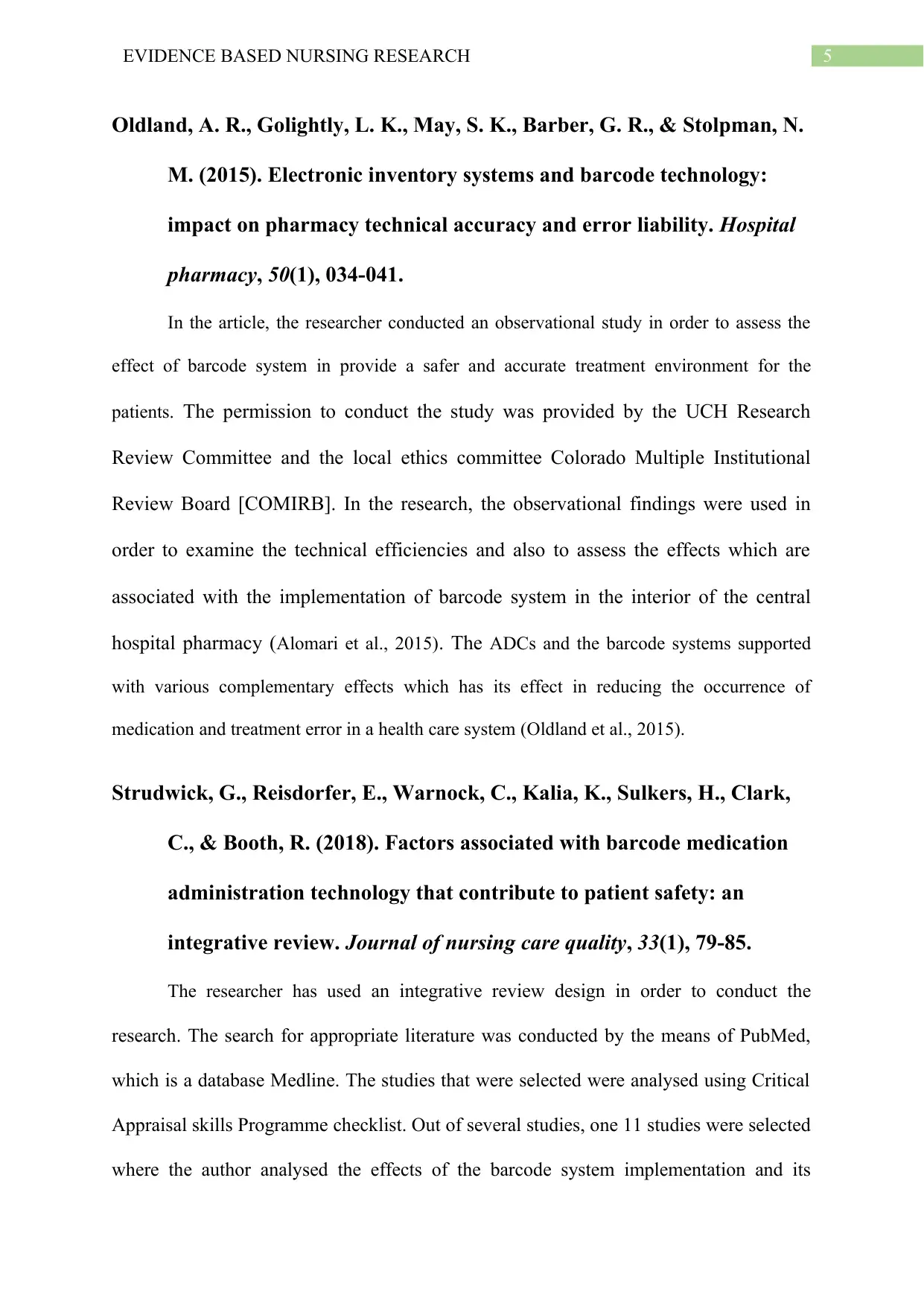
5EVIDENCE BASED NURSING RESEARCH
Oldland, A. R., Golightly, L. K., May, S. K., Barber, G. R., & Stolpman, N.
M. (2015). Electronic inventory systems and barcode technology:
impact on pharmacy technical accuracy and error liability. Hospital
pharmacy, 50(1), 034-041.
In the article, the researcher conducted an observational study in order to assess the
effect of barcode system in provide a safer and accurate treatment environment for the
patients. The permission to conduct the study was provided by the UCH Research
Review Committee and the local ethics committee Colorado Multiple Institutional
Review Board [COMIRB]. In the research, the observational findings were used in
order to examine the technical efficiencies and also to assess the effects which are
associated with the implementation of barcode system in the interior of the central
hospital pharmacy (Alomari et al., 2015). The ADCs and the barcode systems supported
with various complementary effects which has its effect in reducing the occurrence of
medication and treatment error in a health care system (Oldland et al., 2015).
Strudwick, G., Reisdorfer, E., Warnock, C., Kalia, K., Sulkers, H., Clark,
C., & Booth, R. (2018). Factors associated with barcode medication
administration technology that contribute to patient safety: an
integrative review. Journal of nursing care quality, 33(1), 79-85.
The researcher has used an integrative review design in order to conduct the
research. The search for appropriate literature was conducted by the means of PubMed,
which is a database Medline. The studies that were selected were analysed using Critical
Appraisal skills Programme checklist. Out of several studies, one 11 studies were selected
where the author analysed the effects of the barcode system implementation and its
Oldland, A. R., Golightly, L. K., May, S. K., Barber, G. R., & Stolpman, N.
M. (2015). Electronic inventory systems and barcode technology:
impact on pharmacy technical accuracy and error liability. Hospital
pharmacy, 50(1), 034-041.
In the article, the researcher conducted an observational study in order to assess the
effect of barcode system in provide a safer and accurate treatment environment for the
patients. The permission to conduct the study was provided by the UCH Research
Review Committee and the local ethics committee Colorado Multiple Institutional
Review Board [COMIRB]. In the research, the observational findings were used in
order to examine the technical efficiencies and also to assess the effects which are
associated with the implementation of barcode system in the interior of the central
hospital pharmacy (Alomari et al., 2015). The ADCs and the barcode systems supported
with various complementary effects which has its effect in reducing the occurrence of
medication and treatment error in a health care system (Oldland et al., 2015).
Strudwick, G., Reisdorfer, E., Warnock, C., Kalia, K., Sulkers, H., Clark,
C., & Booth, R. (2018). Factors associated with barcode medication
administration technology that contribute to patient safety: an
integrative review. Journal of nursing care quality, 33(1), 79-85.
The researcher has used an integrative review design in order to conduct the
research. The search for appropriate literature was conducted by the means of PubMed,
which is a database Medline. The studies that were selected were analysed using Critical
Appraisal skills Programme checklist. Out of several studies, one 11 studies were selected
where the author analysed the effects of the barcode system implementation and its
⊘ This is a preview!⊘
Do you want full access?
Subscribe today to unlock all pages.

Trusted by 1+ million students worldwide
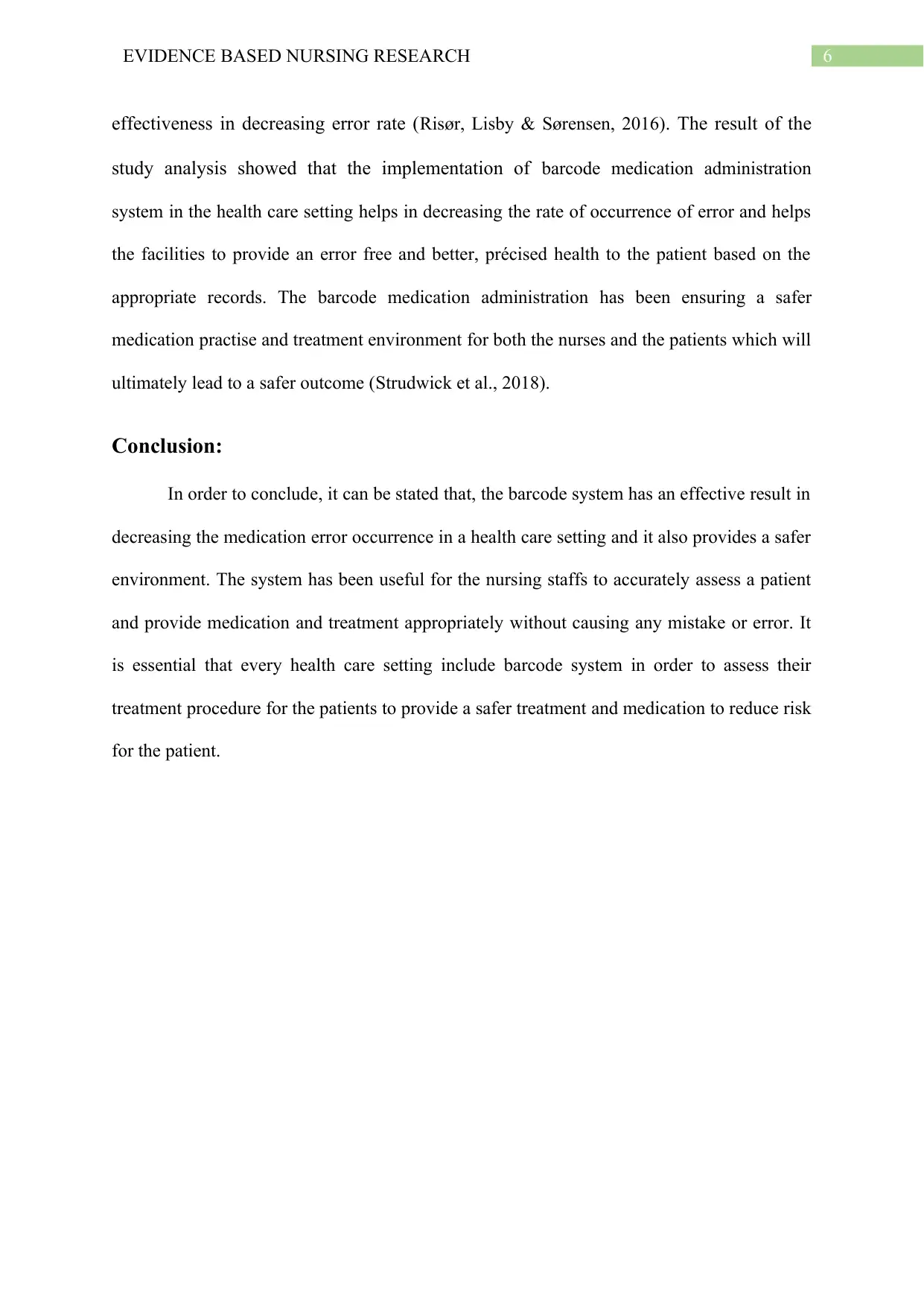
6EVIDENCE BASED NURSING RESEARCH
effectiveness in decreasing error rate (Risør, Lisby & Sørensen, 2016). The result of the
study analysis showed that the implementation of barcode medication administration
system in the health care setting helps in decreasing the rate of occurrence of error and helps
the facilities to provide an error free and better, précised health to the patient based on the
appropriate records. The barcode medication administration has been ensuring a safer
medication practise and treatment environment for both the nurses and the patients which will
ultimately lead to a safer outcome (Strudwick et al., 2018).
Conclusion:
In order to conclude, it can be stated that, the barcode system has an effective result in
decreasing the medication error occurrence in a health care setting and it also provides a safer
environment. The system has been useful for the nursing staffs to accurately assess a patient
and provide medication and treatment appropriately without causing any mistake or error. It
is essential that every health care setting include barcode system in order to assess their
treatment procedure for the patients to provide a safer treatment and medication to reduce risk
for the patient.
effectiveness in decreasing error rate (Risør, Lisby & Sørensen, 2016). The result of the
study analysis showed that the implementation of barcode medication administration
system in the health care setting helps in decreasing the rate of occurrence of error and helps
the facilities to provide an error free and better, précised health to the patient based on the
appropriate records. The barcode medication administration has been ensuring a safer
medication practise and treatment environment for both the nurses and the patients which will
ultimately lead to a safer outcome (Strudwick et al., 2018).
Conclusion:
In order to conclude, it can be stated that, the barcode system has an effective result in
decreasing the medication error occurrence in a health care setting and it also provides a safer
environment. The system has been useful for the nursing staffs to accurately assess a patient
and provide medication and treatment appropriately without causing any mistake or error. It
is essential that every health care setting include barcode system in order to assess their
treatment procedure for the patients to provide a safer treatment and medication to reduce risk
for the patient.
Paraphrase This Document
Need a fresh take? Get an instant paraphrase of this document with our AI Paraphraser
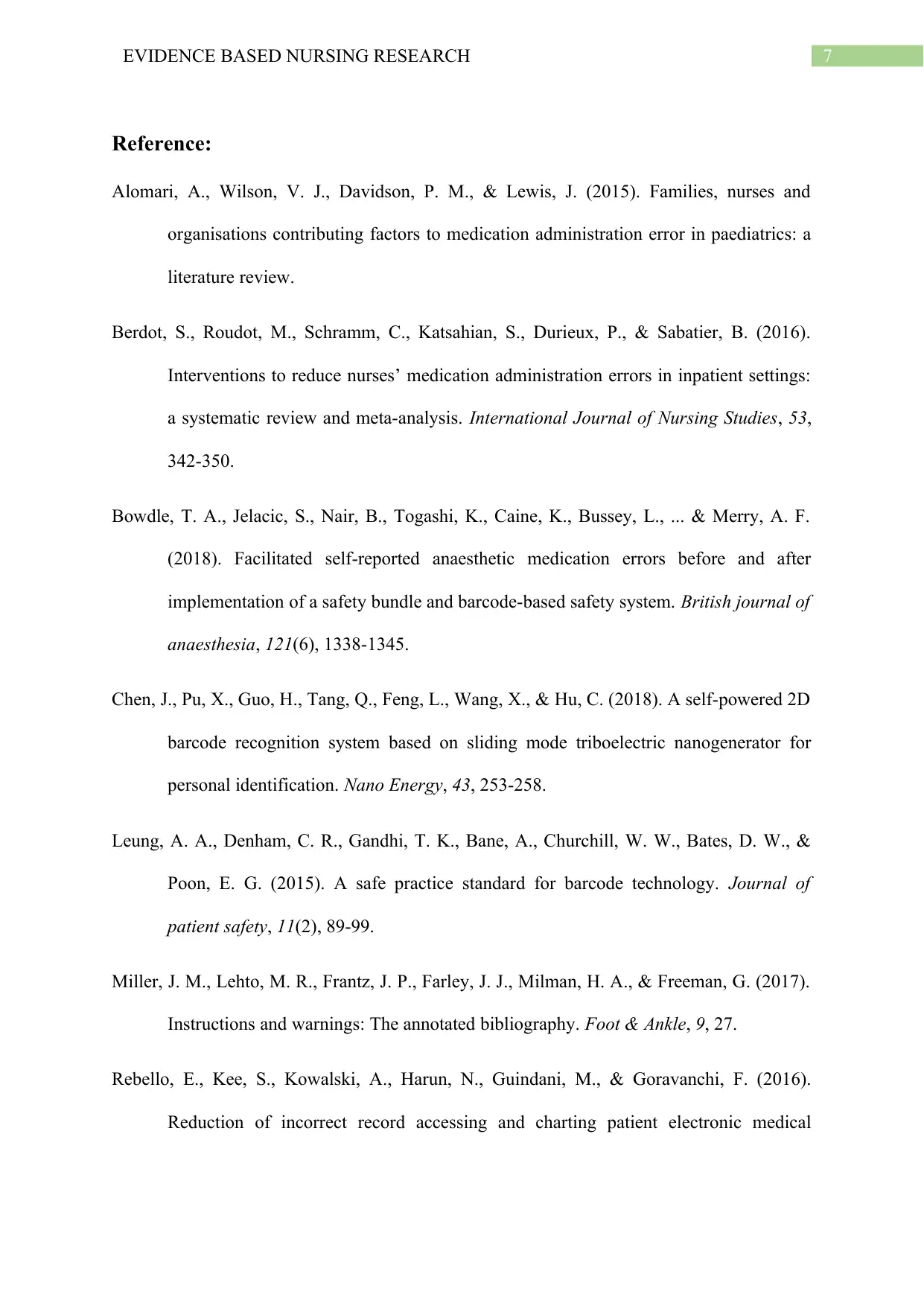
7EVIDENCE BASED NURSING RESEARCH
Reference:
Alomari, A., Wilson, V. J., Davidson, P. M., & Lewis, J. (2015). Families, nurses and
organisations contributing factors to medication administration error in paediatrics: a
literature review.
Berdot, S., Roudot, M., Schramm, C., Katsahian, S., Durieux, P., & Sabatier, B. (2016).
Interventions to reduce nurses’ medication administration errors in inpatient settings:
a systematic review and meta-analysis. International Journal of Nursing Studies, 53,
342-350.
Bowdle, T. A., Jelacic, S., Nair, B., Togashi, K., Caine, K., Bussey, L., ... & Merry, A. F.
(2018). Facilitated self-reported anaesthetic medication errors before and after
implementation of a safety bundle and barcode-based safety system. British journal of
anaesthesia, 121(6), 1338-1345.
Chen, J., Pu, X., Guo, H., Tang, Q., Feng, L., Wang, X., & Hu, C. (2018). A self-powered 2D
barcode recognition system based on sliding mode triboelectric nanogenerator for
personal identification. Nano Energy, 43, 253-258.
Leung, A. A., Denham, C. R., Gandhi, T. K., Bane, A., Churchill, W. W., Bates, D. W., &
Poon, E. G. (2015). A safe practice standard for barcode technology. Journal of
patient safety, 11(2), 89-99.
Miller, J. M., Lehto, M. R., Frantz, J. P., Farley, J. J., Milman, H. A., & Freeman, G. (2017).
Instructions and warnings: The annotated bibliography. Foot & Ankle, 9, 27.
Rebello, E., Kee, S., Kowalski, A., Harun, N., Guindani, M., & Goravanchi, F. (2016).
Reduction of incorrect record accessing and charting patient electronic medical
Reference:
Alomari, A., Wilson, V. J., Davidson, P. M., & Lewis, J. (2015). Families, nurses and
organisations contributing factors to medication administration error in paediatrics: a
literature review.
Berdot, S., Roudot, M., Schramm, C., Katsahian, S., Durieux, P., & Sabatier, B. (2016).
Interventions to reduce nurses’ medication administration errors in inpatient settings:
a systematic review and meta-analysis. International Journal of Nursing Studies, 53,
342-350.
Bowdle, T. A., Jelacic, S., Nair, B., Togashi, K., Caine, K., Bussey, L., ... & Merry, A. F.
(2018). Facilitated self-reported anaesthetic medication errors before and after
implementation of a safety bundle and barcode-based safety system. British journal of
anaesthesia, 121(6), 1338-1345.
Chen, J., Pu, X., Guo, H., Tang, Q., Feng, L., Wang, X., & Hu, C. (2018). A self-powered 2D
barcode recognition system based on sliding mode triboelectric nanogenerator for
personal identification. Nano Energy, 43, 253-258.
Leung, A. A., Denham, C. R., Gandhi, T. K., Bane, A., Churchill, W. W., Bates, D. W., &
Poon, E. G. (2015). A safe practice standard for barcode technology. Journal of
patient safety, 11(2), 89-99.
Miller, J. M., Lehto, M. R., Frantz, J. P., Farley, J. J., Milman, H. A., & Freeman, G. (2017).
Instructions and warnings: The annotated bibliography. Foot & Ankle, 9, 27.
Rebello, E., Kee, S., Kowalski, A., Harun, N., Guindani, M., & Goravanchi, F. (2016).
Reduction of incorrect record accessing and charting patient electronic medical
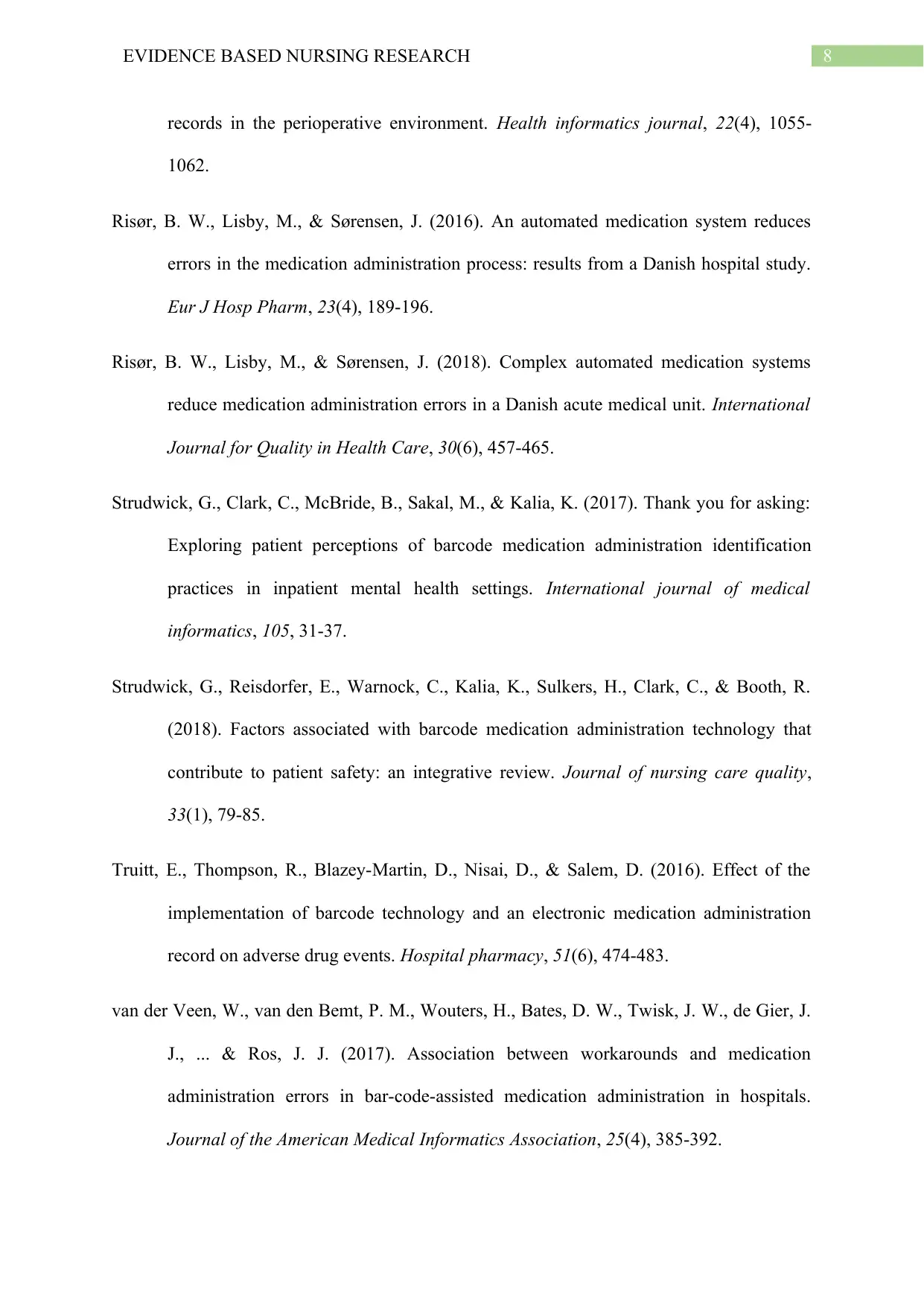
8EVIDENCE BASED NURSING RESEARCH
records in the perioperative environment. Health informatics journal, 22(4), 1055-
1062.
Risør, B. W., Lisby, M., & Sørensen, J. (2016). An automated medication system reduces
errors in the medication administration process: results from a Danish hospital study.
Eur J Hosp Pharm, 23(4), 189-196.
Risør, B. W., Lisby, M., & Sørensen, J. (2018). Complex automated medication systems
reduce medication administration errors in a Danish acute medical unit. International
Journal for Quality in Health Care, 30(6), 457-465.
Strudwick, G., Clark, C., McBride, B., Sakal, M., & Kalia, K. (2017). Thank you for asking:
Exploring patient perceptions of barcode medication administration identification
practices in inpatient mental health settings. International journal of medical
informatics, 105, 31-37.
Strudwick, G., Reisdorfer, E., Warnock, C., Kalia, K., Sulkers, H., Clark, C., & Booth, R.
(2018). Factors associated with barcode medication administration technology that
contribute to patient safety: an integrative review. Journal of nursing care quality,
33(1), 79-85.
Truitt, E., Thompson, R., Blazey-Martin, D., Nisai, D., & Salem, D. (2016). Effect of the
implementation of barcode technology and an electronic medication administration
record on adverse drug events. Hospital pharmacy, 51(6), 474-483.
van der Veen, W., van den Bemt, P. M., Wouters, H., Bates, D. W., Twisk, J. W., de Gier, J.
J., ... & Ros, J. J. (2017). Association between workarounds and medication
administration errors in bar-code-assisted medication administration in hospitals.
Journal of the American Medical Informatics Association, 25(4), 385-392.
records in the perioperative environment. Health informatics journal, 22(4), 1055-
1062.
Risør, B. W., Lisby, M., & Sørensen, J. (2016). An automated medication system reduces
errors in the medication administration process: results from a Danish hospital study.
Eur J Hosp Pharm, 23(4), 189-196.
Risør, B. W., Lisby, M., & Sørensen, J. (2018). Complex automated medication systems
reduce medication administration errors in a Danish acute medical unit. International
Journal for Quality in Health Care, 30(6), 457-465.
Strudwick, G., Clark, C., McBride, B., Sakal, M., & Kalia, K. (2017). Thank you for asking:
Exploring patient perceptions of barcode medication administration identification
practices in inpatient mental health settings. International journal of medical
informatics, 105, 31-37.
Strudwick, G., Reisdorfer, E., Warnock, C., Kalia, K., Sulkers, H., Clark, C., & Booth, R.
(2018). Factors associated with barcode medication administration technology that
contribute to patient safety: an integrative review. Journal of nursing care quality,
33(1), 79-85.
Truitt, E., Thompson, R., Blazey-Martin, D., Nisai, D., & Salem, D. (2016). Effect of the
implementation of barcode technology and an electronic medication administration
record on adverse drug events. Hospital pharmacy, 51(6), 474-483.
van der Veen, W., van den Bemt, P. M., Wouters, H., Bates, D. W., Twisk, J. W., de Gier, J.
J., ... & Ros, J. J. (2017). Association between workarounds and medication
administration errors in bar-code-assisted medication administration in hospitals.
Journal of the American Medical Informatics Association, 25(4), 385-392.
⊘ This is a preview!⊘
Do you want full access?
Subscribe today to unlock all pages.

Trusted by 1+ million students worldwide

9EVIDENCE BASED NURSING RESEARCH
Xie, N., Kalia, K., Strudwick, G., & Lau, F. (2019). Understanding Mental Health Nurses’
Perceptions of Barcode Medication Administration: A Qualitative Descriptive Study.
Issues in mental health nursing, 1-9.
Xie, N., Kalia, K., Strudwick, G., & Lau, F. (2019). Understanding Mental Health Nurses’
Perceptions of Barcode Medication Administration: A Qualitative Descriptive Study.
Issues in mental health nursing, 1-9.
1 out of 10
Related Documents
Your All-in-One AI-Powered Toolkit for Academic Success.
+13062052269
info@desklib.com
Available 24*7 on WhatsApp / Email
![[object Object]](/_next/static/media/star-bottom.7253800d.svg)
Unlock your academic potential
Copyright © 2020–2025 A2Z Services. All Rights Reserved. Developed and managed by ZUCOL.





